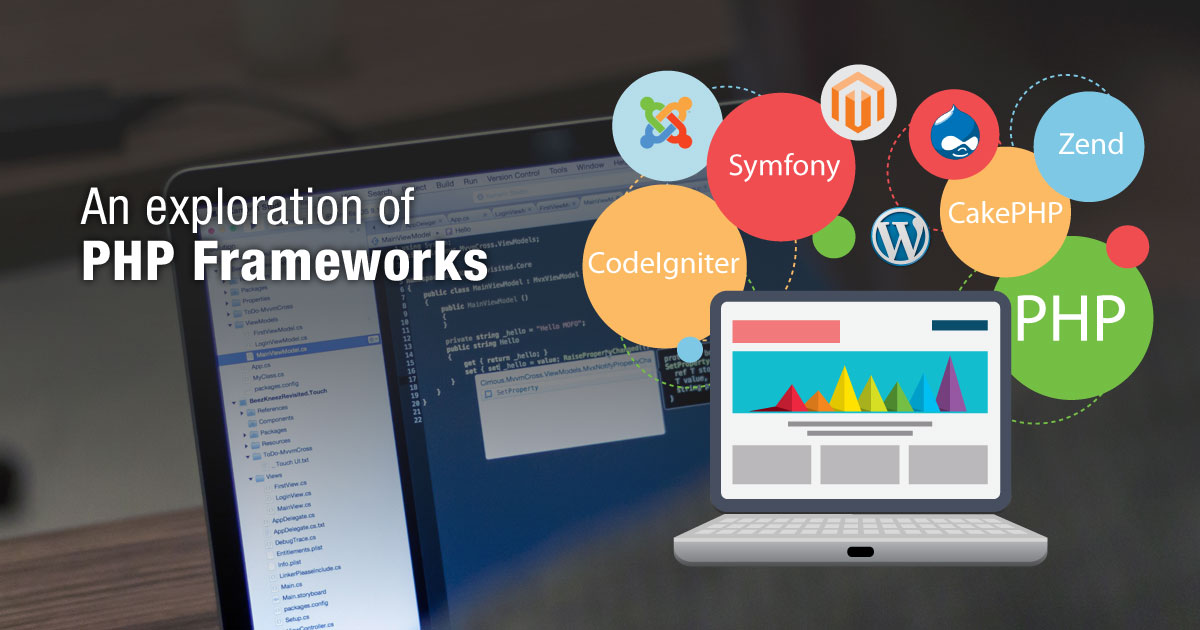PHP framework is the canvas where a developer creates code. Using a high-quality PHP framework is essential to creating a clean, stable, and error-free site. Coders bask in the rich open-source community, piles of documentation, resources galore, and a flexible user interface.
The growing popularity of PHP has led to a variety of MVC platforms to choose from. So which one is the best for your project? The question merits a deeper exploration of PHP frameworks. While there are many out there, we will dive into the following four: Zend, CodeIgniter, CakePHP, and Symfony.
On a high level, each framework has its strengths and weaknesses. However, the choice could be based on the type of the site you plan to build, and the demands of the project. In the decision for the framework, the project size, timeframe, and the level of skills in PHP are the key variables.

Let’s take a closer look:
CodeIgniter
The CodeIgniter PHP framework is very famous among developers because of its light weight and efficiency. So CodeIgniter is the preferred framework for web application development because of these features. In 2024, the technology continues to stay relevant for the developer's society, providing many updates and keeping it at the same level of a good framework for both small and big projects.
# Streamlined Development
What makes CodeIgniter so alluring is its simplicity and elegance, useful for developers to build highly interactive and fully featured web applications without excess complexity. Compactness does not compromise functionality, being a functional solution for almost all projects.
# Framework Comparison
If you compare CodeIgniter to Laravel (one of the leading PHP frameworks), CodeIgniter is suggested to be for smaller projects because of its simplicity and ease of use. As compared to Laravel, it may be suitable for larger and more complicated projects. On one hand, this division aids developers with their selection of a framework either based on project size or complexity.
# Community and Support
The CodeIgniter community with its wide documentation forums, wiki pages, and tutorials is still very active and helpful. This abundance of resources informs developers as they keep seeking for the necessary information and solutions during their projects.
# Versatility and User-Friendly Tools
CodeIgniter is appreciated for its developer-oriented tools which enable people with the knowledge of programming to construct stunning websites and not stick to the tight coding principles of some other frameworks. Besides, the flexibility it brings is only suitable with responsibility for proper coding techniques to preserve coherence and quality in the codebase.
# Maintenance and Security Updates
The infrastructure is currently in maintenance mode with its main objective of security updates. The latest version is 3.1.13, researched at the time of writing this essay. Adopting this method helps to keep CodeIgniter safe and reliable for those who make use of it and their projects.
# Dynamic Web Development
CodeIgniter's continuous updates and community member support demonstrate it is capable of adapting to the changing nature of web development. It still has a balanced measure of speed, simplicity, and strength, hence, developers are most likely to see it as a plausible option in 2024.
Symfony
Symfony has a lot to offer and in addition to ORM and its unique "Bundles" concept, it also makes the code development process easier for an easier overall development process. Although it entails a steep learning curve, the framework’s stability and supportive community drive its quality and make it a highly desirable choice for projects with large database integrations.
# Release Cycle
Symfony releases are generally semi-annual, each major leap being taken every May and November. This scheduled release enables developers and organizations to plan their environments on the latest features without any surprises (source).
# Community and Support
The Symfony community constantly publishes updates as well which include thorough release notes and notifications of enhancements. The official Symfony Blog is the central gateway for these communications, besides which it contains tutorials, case studies, and other major announcements. This neighborhood affection is proof that Symfony is the top framework for web designing (source at her disposal).
Symfony remains an enormous framework for the management of big projects, which rely on Object-Relational Mapping (ORM) and the advanced "Bundles" concept for quick and cleaner coding. Although it can be a rather daunting learning curve, one can conclude that the framework's robustness and supportive community enable it to be a good choice for projects with heavy database integration.
CakePHP
The skyrocketing popularity of the CakePHP framework this 2024 cannot be denied, which has made it one of the greatest players in the PHP framework landscape. The technology is famous for its effectiveness and scalability. It suits the developers' needs for the full range of projects they are involved with. Here are some of the most noteworthy features:
# Learning Resources
The CakePHP Cookbook is to be re-vamped as of March 19, 2024, and it will provide the most detailed information for CakePHP 4. x users– both new and experienced programmers. It shows that the framework is constantly updated and well-documented.
# Development Trends
CakePHP remains on the pedestal for enthusiastic developers wishing to enjoy a robust and flexible framework. In 2024, it shows that the skill brings projects on target in terms of efficiency and scalability, as many LinkedIn platforms have confirmed.
# Framework Updates
The world around the PHP framework involving the CakePHP is the one everywhere with improvements and upgrades. CakePHP, which is a well-known one in this field and among other famous frameworks, such as Symfony and Laravel, contributes greatly to the development of the current web evolution, thus assuring its continued relevance and power for modern web development needs.
# PHP Compatibility
The important thing is that CakePHP 4. x demands PHP 7.2 as a minimum while developers are advised to increase it to PHP 8.0 to take advantage of the latest features and improvements in the framework.
# Migration and Upgrades
If you are considering a move from CakePHP 2 or upgrading to CakePHP 5, you will find resources there to walk you through the process. Switching to CakePHP 5 is advised in 2024, promising improvement to all features for developers, managers, as well as investors.
Zend
Just like Symfony, the Zend framework is adapted for enterprise-level programming. It's the complexity and the modularity that, at the same time, make it a perfect platform to master but also a challenging framework. While its stability, feature integration, and security distinguished it among the developers who work on big-scale application frameworks, it is a preferred choice of the developers.
So far, one can see the emergence of new features in the new versions of Zend Server. These are mainly for reducing performance issues with PHP and providing a full-featured development environment for PHP developers. The improved features comprise PHP version compatibility, which makes it more sensitive and operative in performing modern web development requirements.
# Community Insights
However, the Zend Framework community is still vibrant and helpful, which makes it even more generalized and significant in the whole PHP world. An increase in the other frameworks such as Symfony and Laravel cannot undermine Zend (now Laminas) which is strengthened by a strong community and continuous updates. This community backing set up developers with different sources, and the wealth of knowledge resources ease their way out of framework complexities.
# The Shift to Laminas
It might be mentioned the switch to the Laminas Project acknowledges the new style of Zend Framework. This is done to enhance the framework’s longevity and growth were the two main considerations. There is an attempt to embed community involvement and open-source collaboration. The Laminas Project stays committed to the traditions of the Zend brand that epitomizes robustness, high-end security, and enterprise-level focus.
Which Is the Right One For Me?
It can be best answered by carefully evaluating your development team and the extent of the project that you are planning to work on. Add PHP skills to your requirements for choosing a framework too. Big-sized projects must be in the framework of Zend or Symfony which are very solid and work under specific rules.
If the speed and ease of use is a matter, CodeIgniter or CakePHP, which are lighter frameworks may be the correct options. While one framework may fit your needs better than another, most of the popular frameworks share a common trait: great documentation and help forums. At the end of the day, picking the right framework is best answered by reflecting on the project itself.


